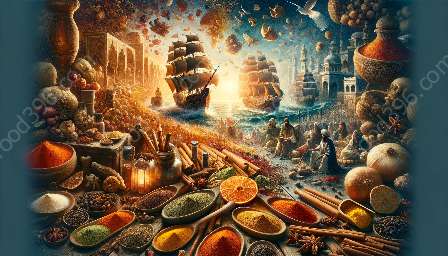The Silk Road and spice trade hold a mystique that has captured the imagination for centuries, connecting the East and West through a network of ancient trade routes. These historic trade routes weren't just about the exchange of goods; they facilitated the flow of ideas, culture, and innovation across different civilizations.
The Silk Road: A Path of Synthesis
The Silk Road was not a single route but a network of interconnected trade routes that connected the Mediterranean, Europe, Africa, and Asia. It facilitated the exchange of silk, spices, precious metals, and other commodities, serving as a vital conduit for cultural exchange between the East and West. It enabled the transmission of knowledge and ideas, including those related to spices and food.
Spices and Their Role in the Silk Road
Spices played a crucial role in the trade along the Silk Road. They were often more valuable than gold and precious stones, serving as a symbol of wealth and status. The demand for exotic spices such as cinnamon, pepper, cloves, and nutmeg drove the expansion of trade routes and the development of new sea routes by various civilizations.
These aromatic treasures were used not only to flavor and preserve food but also to mask the taste and odor of preserved meats. They also held medicinal and religious significance, making them highly sought after commodities.
The Spice Trade and Its Influence on History
The history of spices and their trade is intertwined with the Silk Road, contributing to the rise and fall of empires, and influencing global exploration and colonization. The quest for spices played a pivotal role in the Age of Discovery, prompting voyages and expeditions to find new trade routes and sources of valuable spices.
Spices such as pepper, cinnamon, and ginger held immense economic and cultural significance, shaping the economies and culinary traditions of societies across the ancient world. The allure of these spices continues to resonate in modern cuisine and global trade.
From Spice Routes to Food Cultures
The trade of spices along the Silk Road not only shaped the course of history but also had a profound impact on food culture. The introduction of new spices and culinary techniques led to the fusion of different food traditions, giving rise to unique and diverse cuisines.
The Evolution of Food Culture
The exchange of spices, cooking methods, and culinary traditions along the Silk Road led to the enrichment and evolution of food cultures in different regions. New spices introduced new flavors and aromas, inspiring chefs and home cooks to experiment with novel combinations and preparations.
Spices became an integral part of food culture, symbolizing cultural identity and social status. They found their way into traditional dishes, beverages, and even confections, creating a tapestry of flavors that continues to define the culinary heritage of various countries.
Historical Significance of Spices in Food Culture
The historical significance of spices in food culture extends beyond their culinary applications. Spices became symbols of sophistication and luxury, often reserved for special occasions and feasts. They also played a role in shaping rituals and traditions related to food preparation and consumption.
In essence, the spice trade not only contributed to the globalization of flavors but also influenced the rituals, customs, and social dynamics surrounding food, creating a rich tapestry of gastronomic heritage.
Unveiling the Roots of History Through Spices and Food
Exploring the intertwined worlds of the Silk Road, spice trade, and food culture unravels the intricate tapestry of history. The journey of spices and the routes they traversed paint a vivid picture of ancient trade, cultural exchange, and the evolution of culinary traditions.
Navigating the Historical Spice Routes
Tracing the historical spice routes uncovers the interconnectedness of civilizations and the profound impact of spice trade on the development of societies. It reveals the stories of enterprising traders, adventurers, and explorers who ventured across vast distances in search of the most prized spices, shaping the geopolitical landscape of their time.
The spice routes also illuminate the adaptability and creativity of human societies in integrating diverse ingredients and culinary practices, resulting in the melting pot of flavors found in modern cuisines.
Preserving Culinary and Historical Heritage
The legacy of spice trade and its influence on food culture persists in the culinary traditions and historical narratives of different regions. Through the preservation of traditional recipes, culinary techniques, and stories of spice trade, we honor the enduring legacy of the Silk Road and the spice trade.
By celebrating the historical roots of spices and their role in shaping food culture, we pay homage to the resilience and innovation of ancient civilizations and recognize the ongoing impact of their legacy on our culinary experiences and cultural heritage today.

